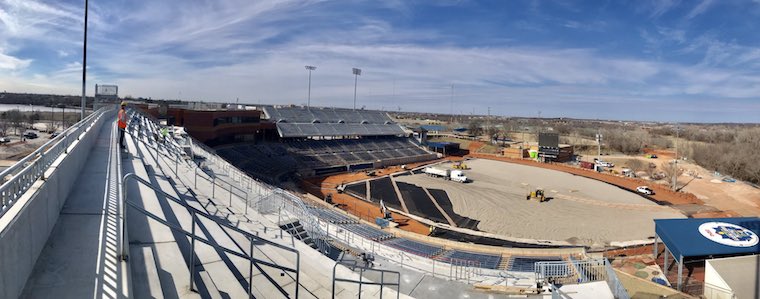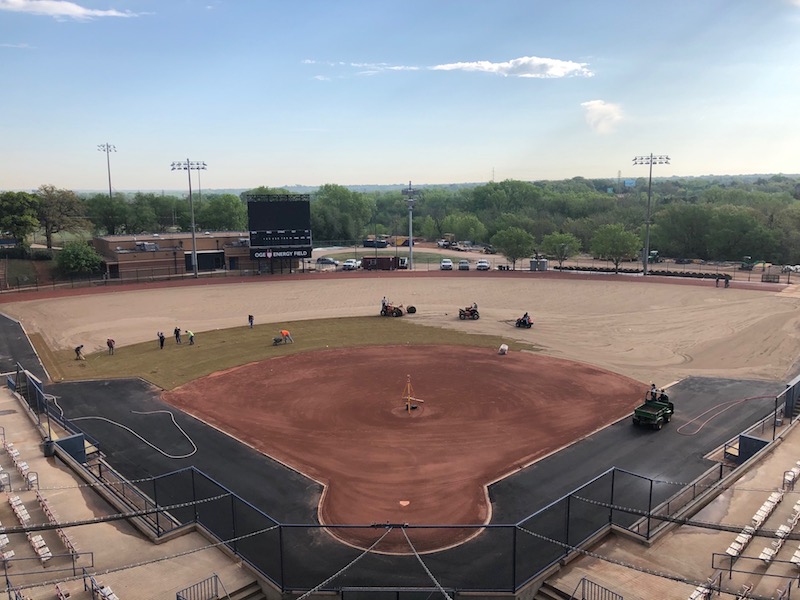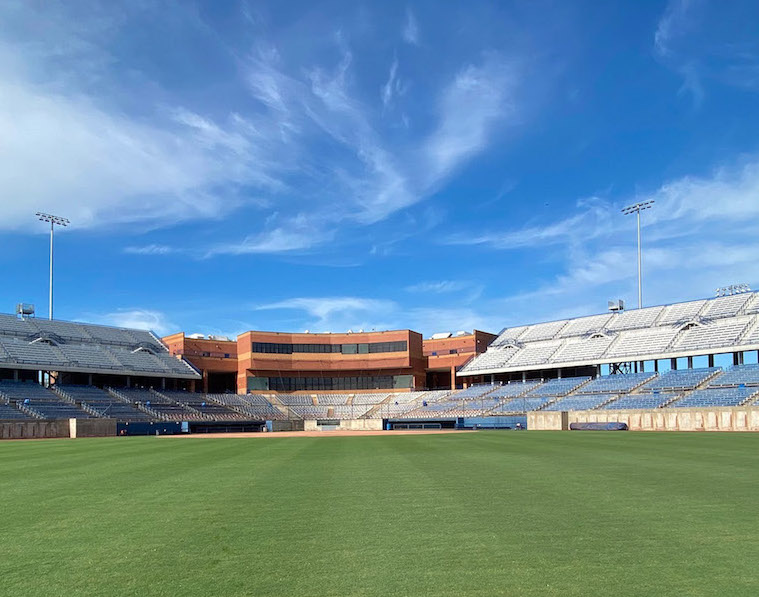By Stacie Zinn Roberts
Rain delays in softball are nothing new. If you play a game outdoors, eventually you’re going to get a little wet. But at the USA Softball Hall of Fame Complex stadium field in Oklahoma City, Chuck White, sports turf manager there for the past five years*, had a real problem. As the home of USA Softball, and host to nearly 30 events each year, including the NCAA Women’s College World Series (WCWS), the most high-profile field in the sport was drowning. Every time it rained, torrents of water rushed down the slope of the stadium seats, pouring water toward the playing surface like a funnel. The deluge surged into the dugouts, flooded the locker rooms beyond, and pooled on the field.
The USA Softball Hall of Fame – OGE&E Energy Field – was originally built in 1985 with approximately 1,000 seats. Since that time, the field surface, which was constructed on a sandstone base, had not been renovated. The concrete bleacher seating capacity, however, had incrementally increased to accommodate 5,000 fans.
“The problem we had was the field, when it was built originally, was not designed to take the water that comes off of 5,000 concrete seats down onto the field,” said White. “The water would come onto the field from the bleacher area and would basically explode the field out. There was no way the water could leave. We had a real drainage and water management issue.” Sandstone, he added, “obviously cannot handle the water. There was no way for it to get out. We had about a foot of topsoil, native soil and that’s it.”
Under normal conditions, a flooded field would be an inconvenience. A flood during the NCAA WCWS, well, that’s a disaster. And it happened not once, but twice.
“The first year I was here, during the 2015 College World Series, we had probably one of the wettest Junes in the history of Oklahoma. I had to put two tarps on the field to be able to shift the water to the point that we could play,” White said. “Then, in 2017, we had a rain shower during play and we got so much rain that we could not handle it, and it would not drain. We had to suspend the game and finish up the next day.”
Something had to be done. A $27.5 million major renovation of the complex was voted on and approved by the local taxpayers who own the property and lease it to USA Softball. The renovation would add another 4,000 seats to the stadium, new restrooms and other interior improvements. Nearly $2 million of the renovation budget was earmarked for the field itself to install a new drainage system, new irrigation system, new infield dirt, warning track and 52,000 square feet of Tahoma 31 bermudagrass sod in the outfield.

The renovation
A softball field fit for the U.S. Olympic Softball Team, and a project of this scale, requires a lot of expertise. Timberlake Construction was the general contractor. United Turf & Track did the field construction in conjunction with Floyd Sports Engineering.
“They took the existing field and excavated it down 18 inches to get it down to where it’s supposed to be, and then they started building it back,” said White. “They built a drainage system, a network of drainage. On top of that, there’s four inches of gravel across the whole field. And then underneath the grass surface, there’s eight inches of sand. We have Tahoma 31, a hybrid bermuda that we have installed on the field. Tahoma 31 was developed out of Oklahoma State in Stillwater, Oklahoma, specifically for this transitional zone. It’s cold tolerant. In other words, it will start earlier in the year, in February and March. It’s drought tolerant, it does not take as much water or need it as much. It repairs itself very quickly. And it will also stay green longer into October or November in the climate zone that we’re in, in Oklahoma.”
The subsurface drainage was designed specifically to solve the water management issue.
“The grass surface can handle up to 15 inches per hour of rain because of the new drainage system,” said White. “The infield surface has the same thing, it has the drainage, it has the gravel, then it has four inches of sand, and then it has four inches of engineered infield mix. It’s called Pro Red and it.s furnished by Stabilizer Solutions out of Phoenix, Arizona.”
For Jefff Salmond, CSFM, (2017 president of STMA), of United Track & Turf, a sports field construction firm based in Arcadia, Oklahoma, Hall of Fame Stadium is the third Tahoma 31 project he’s installed in the past year, following a soccer field at University of Tulsa and the University of Arkansas football field.
This renovation was a multi-step process. After excavating down a foot and a half, installing new drainage, gravel and the sand cap, Salmond said his firm installed four distinct playing surfaces at the Hall of Fame Stadium: the skinned-in infield; Hilltopper warning track; bermudagrass sod outfield; and artificial turf along the sidelines, infield warning track and wing areas on either side of home plate. The Astroturf RBI system in the infield is comprised of synthetic turf over asphalt and a pad.
“The reason why it was designed that way was for the amount of traffic that the sideline area gets, they felt that it was important that they had that stable asphalt underneath it but they also had the pad on it for shock absorption,” said Salmond.

Sod prep
Even though Tahoma 31 is a relatively new variety, Charles Binney has grown the grass at Riverview Sod Ranch near Tulsa for five years. His farm cooperated with Oklahoma State University as a test site for the grass while it was in research and development. The sod farm now has some 90 acres in production.
“With other grasses, usually the sprigs come up as little bitty pieces. Tahoma 31 is so dense, it comes up the size of a golf ball,” said Binney. “The density is so incredible that we had to buy new tractors to have more horsepower to mow it. When you stick a cleat in this kind of grass, you get better traction.”
The sod was grown on a farm field with a sand/silt soil. Thirty days before harvest, Binney applied a 50/50 mix of potassium and potash at 250 pounds per acre to the sod to encourage root growth and add carbohydrates to the plant, so, as Binney said, “it’s ready to rock and roll” when installed.
Binney suggested that Salmond apply the same rate of potassium and potash, incorporated into the top three inches of the USGA sand about five days before installation. As the USGA sand has no real nutrients in it, the roots of the newly cut sod will seek out the fertilizer through the sand and tack down faster.
Renovation in the time of COVID-19
The renovation began December 1, 2019, with the goal of completion in time for the NCAA WCWS first day of play on May 28, 2020. The project was completed on April 21, 2020, in plenty of time to host the event. Unfortunately, COVID-19 had other plans. The NCAA WCWS was scrapped for 2020.
Still, in the winter and spring of 2020, uncertainty about the pandemic was rampant. No one knew at the time how the virus would eventually cause the cancellation of so many sporting events. The construction crews practiced social distancing and the field construction went ahead in case the event was to be played.
“We couldn’t stop. You know, we didn’t know what was going to happen, if restrictions were going to get lifted, or if they were going to continue,” said Salmond. “We had a field that we had to have ready.”
The deadline came and went. Vacant stands sat empty. Players stayed home. ESPN’s camera crews never arrived. It was frustrating for White and USA Softball.
“You get really psyched up, you go out and you get all your staffing in place, and all your materials and everything going, and then you find out you’re not going to have it. It’s a real letdown,” said White.
That disappointment was short lived, however. A month later, with COVID safety protocols in place, the facility hosted the USA Softball HFL July 4th showdown, a regional fastpitch tournament.
“The playing surface did well considering it’s only two months old,” said White. “The Tahoma 31 did exceptionally well. It showed very little sign of wear in the out position areas.”
Rave reviews for the field poured in.
“The facilities are second to none. The new renovations and playing surface were excellent,” said Ryan Taylor, who oversees the Aces Fastpitch organization and is the Commissioner of the HFL, as quoted in news reports following the tournament.
At a press tour of the renovated facility held in June, USA Softball CEO Craig Cress said, “This is the best softball facility in the world… I sit on the International Softball Board, so trust me when I say that. This is the premiere facility in the United States and in the world for our athletes.”
While accolades are gratifying, White said the renovation solved so many of the issues he’s battled for years.
“In a regular season, we will start games first in March and we will play, depending upon the year, anywhere from 23 to 28 events from March until the middle of October. Our field will get a lot of play. When people come to the Hall of Fame, they basically come for one reason. They want to play on the Hall of Fame Stadium field, the championship field, so that field gets no rest at all. It’s got a solid schedule. People play on this week in and week out. I’ve got to have a field that can handle the water because we’re going to have events that catch rain. I’ve got to be able to get rid of the water,” said White.
“I also need a field that can repair quickly because we have eight, 10, 12 games a day and that’s a lot of traffic in the three-day period because most of our tournaments are on a Friday or Saturday and Sunday,” White added. “We catch so much traffic on our field that we have to have a surface that can help us manage the water issues both on the dirt and on the grass, and will also help us manage the high traffic issues. Tahoma 31 is a very thin blade, very tight grass so it handles the traffic much better than the old common bermuda that we had. So far from what we’ve seen of Tahoma 31, we love it.”
* Chuck White resigned from USA Softball at the end of July and has officially started “Full Scope Restoration,” his own sports field management business headquartered in Oklahoma.
Stacie Zinn Roberts is a writer, marketing strategist and president of What’s Your Avocado? Marketing and PR, Mount Vernon, Wash. These materials were provided by Tahoma 31.


